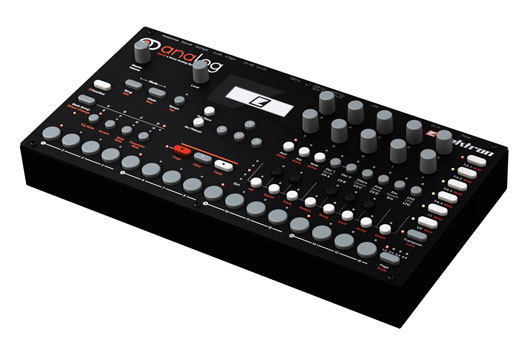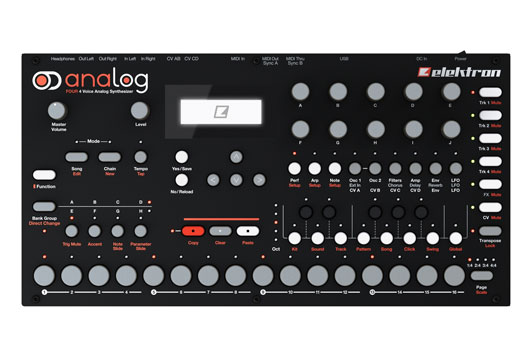Review: Elektron Analog Four
Swedish company Elektron has built up a cult following over the years with boutique instruments […]

Swedish company Elektron has built up a cult following over the years with boutique instruments like the Machinedrum and Octatrack, and its innovative parameter locks and exacting controls have been ripped off by loads of plug-ins. However, Elektron’s latest offering, the Analog Four, is unlikely to be ripped off anytime soon, at least not by software developers. The Analog Four uses an analog signal path with digital controls, similar to a few classic Roland synths from the ’80s. It also crams together a surprising amount of CV outs, integrated effects, and performance-oriented knobs and buttons that tend to make hardware instantly fun. As such, the Analog Four attempts to capitalizes on all the things that software (still) isn’t very good at, while maintaining the sequencing and control that Elektron is famous for.
How It Looks
The Analog Four is housed in a black steel case that bears the stylish mark of Elektron’s collaborations with Swedish design company Acne. A number of grey, white, and red plastic buttons are stiff but playful, and do everything from selecting steps in a sequence to serving as a mini, one-octave keyboard. Its 12 rubberized knobs have a strong and authoritative stance, begging for dramatic twisting of filters and envelope parameters. Finally, a 122×32 LCD screen gives you a majority of the useful information needed to edit patches, dive through menus, and change settings of various types. Compared to Elektron’s other recent product, the Octrack, the Analog Four’s interface seems less complicated, despite the screen being smaller and its need for having manual at the ready while first navigating the thing.

How It Works
A good monosynth tends to be controlled by one knob for each function, which gives an immediacy that makes programming fun. By contrast, the Analog Four is far from a one-knob-per-function synth, but it’s still fun because of how the four monosynths tie into the sequencer. For example: If you make a new sound, you can audition it on the keyboard, or you can immediately start sequencing and sculpt the sound as you go. The latter style of working is nothing new to anyone that works with software sequencers, but the difference here is how easy it is to make evolving sequences using parameter locks. Almost every parameter on the Analog Four can be locked to a sequence step, allowing you to make subtle changes and/or play completely different patches per step.
Reserved to their own “tracks,” each of the four monosynths are dual oscillator with a sub that can be tuned to a fifth or up to two octaves below the primary pitch. The standard triangle, pulse, and sawtooth waveforms are present, and they all have variable width, which is somewhat unusual. There’s also some unusual oscillator modulation options, like soft and metal sync, which are great for adding unpredictability. The signal then routes into a four-pole low-pass filter that has a very familiar squelch at high resonance.
After the ladder filter, the signal passes through an overdrive circuit that has soft and hard clipping options. Extreme values dirty up the sound significantly, but volume is reduced quite a bit, which can be mitigated by using internal routing (neighbor tracks) to boost the volume. The advantage of this approach is that you can run your sound through an additional analog signal path, albeit at the cost of an oscillator on the next track. Finally, there’s a gentle multimode filter that is great for defining and cleaning up sounds, yet still capable of high resonance extremes.
Similar to Elektron’s Monomachine, the modulation section for each track is thorough, as it boasts two envelopes with several linear and exponential curves, in addition to two assignable LFOs with a multitude of shapes and repeat options. The LFOs are a particular standout, as they can be used for everything from pseudo-envelope work to fake sidechain effects.
How It Sounds
Without using any of Elektron’s parameter locks or advanced features, the sound of the Analog Four’s oscillators and filters are warm and almost soft, at least by Elektron standards. A lot of comparisons have been thrown around, but we’ve found it to be reminiscent of a brighter, edgier Roland Alpha Juno 2—which actually means surprisingly little since half of the “Elektron sound” comes from the sequencer and modulation.
The Analog Four is meant to be deep in a very performance-oriented way, so it’s hard to discuss its sound without considering all of the options and control at your disposal. For example, even the arpeggiators are essentially synth engines and mini-sequencers, capable of both ultra-fast speeds for video game-like effects and easily programmed rhythmic and pitch variation.
Likewise, the global effects section is surprisingly good and completely parameter lockable. Each track has individual sends to chorus, delay, and reverb, and you can parameter lock all of the effect settings as well—which is useful for tempo-matched reverb swells and oddball delay effects, among other things. The chorus is gritty and thick, and apparently good for making No U-Turn-style bass tones if you happen to be stuck in 1997.
The Bottom Line
The Analog Four is a clever hybrid of analog signal path and digital control, grabbing all of the best elements from both worlds. It’s not a jack-of-all-trades machine—there’s no poly mode (yet), and it can only sequence external gear via CV outs. But that might only be a problem if you wish that it could do everything; there’s so much power and variety crammed into the machine that can hardly be covered by the manual, let alone a review.
MSRP: $1149.00

